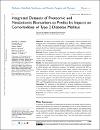Integrated datasets of proteomic and metabolomic biomarkers to predict its impacts on comorbidities of type 2 diabetes mellitus
| Author | Cheema, Amrita K. |
| Author | Kaur, Prabhjit |
| Author | Fadel, Amina |
| Author | Younes, Noura |
| Author | Zirie, Mahmoud |
| Author | Rizk, Nasser M. |
| Available date | 2020-07-21T07:46:23Z |
| Publication Date | 2020-01-01 |
| Publication Name | Diabetes, Metabolic Syndrome and Obesity: Targets and Therapy |
| Identifier | http://dx.doi.org/10.2147/DMSO.S244432 |
| Citation | Cheema AK, Kaur P, Fadel A, Younes N, Zirie M, Rizk NM. Integrated Datasets of Proteomic and Metabolomic Biomarkers to Predict Its Impacts on Comorbidities of Type 2 Diabetes Mellitus. Diabetes Metab Syndr Obes. 2020;13:2409-2431 https://doi.org/10.2147/DMSO.S244432 |
| Abstract | © 2020 Cheema et al. Objective: The objective of the current study is to accomplish a relative exploration of the biological roles of differentially dysregulated genes (DRGs) in type 2 diabetes mellitus (T2DM). The study aimed to determine the impact of these DRGs on the biological pathways and networks that are related to the associated disorders and complications in T2DM and to predict its role as prospective biomarkers. Methods: Datasets obtained from metabolomic and proteomic profiling were used for investigation of the differential expression of the genes. A subset of DRGs was integrated into IPA software to explore its biological pathways, related diseases, and their regulation in T2DM. Upon entry into the IPA, only 94 of the DRGs were recognizable, mapped, and matched within the database. Results: The study identified networks that explore the dysregulation of several functions; cell components such as degranulation of cells; molecular transport process and metabolism of cellular proteins; and inflammatory responses. Top disorders associated with DRGs in T2DM are related to organ injuries such as renal damage, connective tissue disorders, and acute inflammatory disorders. Upstream regulator analysis predicted the role of several transcription factors of interest, such as STAT3 and HIF alpha, as well as many kinases such as JAK kinases, which affects the gene expression of the dataset in T2DM. Interleukin 6 (IL6) is the top regulator of the DRGs, followed by leptin (LEP). Monitoring the dysregulation of the coupled expression of the following biomarkers (TNF, IL6, LEP, AGT, APOE, F2, SPP1, and INS) highlights that they could be used as potential prognostic biomarkers. Conclusion: The integration of data obtained by advanced metabolomic and proteomic technologies has made it probable to advantage in understanding the role of these biomarkers in the identification of significant biological processes, pathways, and regulators that are associated with T2DM and its comorbidities. |
| Language | en |
| Publisher | Dove Medical Press |
| Subject | Bioinformatics Biomarkers Disorders Pathway analysis Regulators Type 2 diabetes mellitus |
| Type | Article |
| Pagination | 2409–2431 |
| Volume Number | 13 |
Files in this item
This item appears in the following Collection(s)
-
Biomedical Research Center Research [838 items ]
-
Biomedical Sciences [847 items ]


